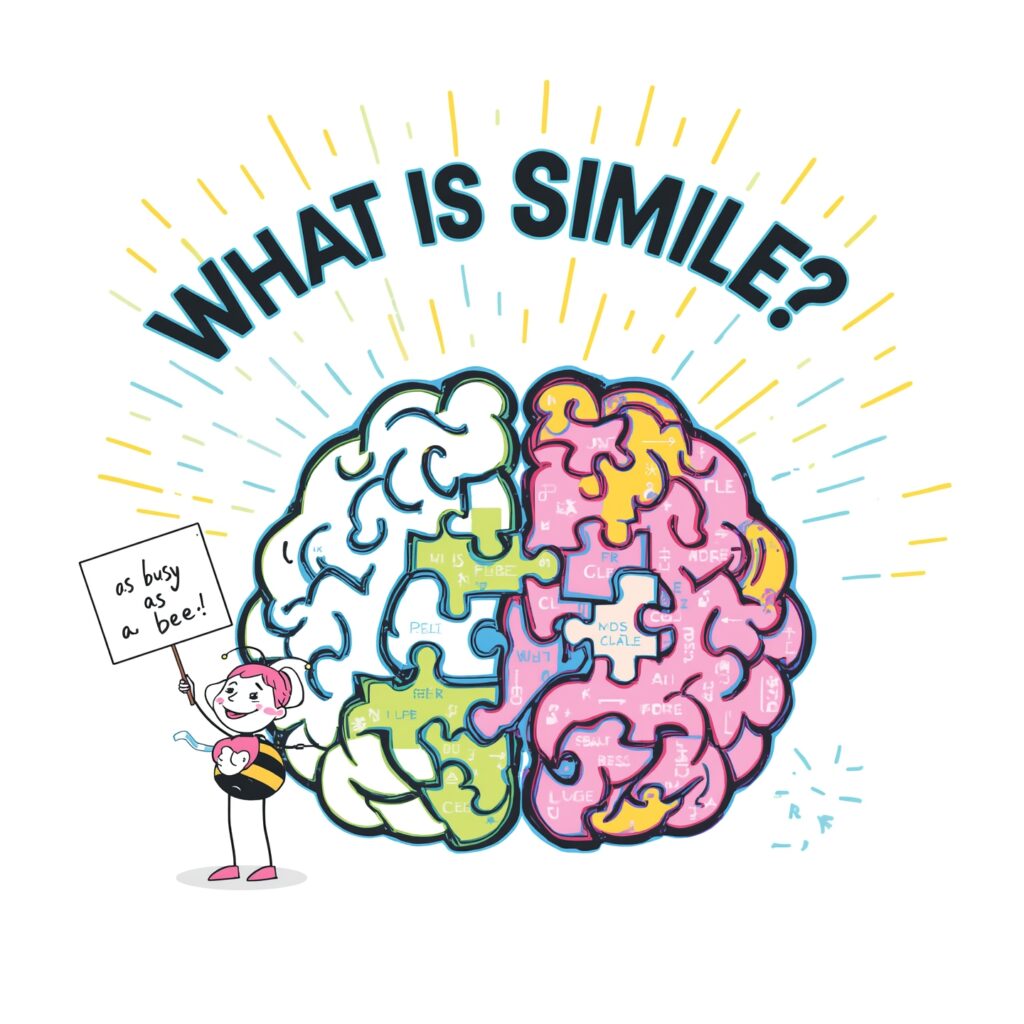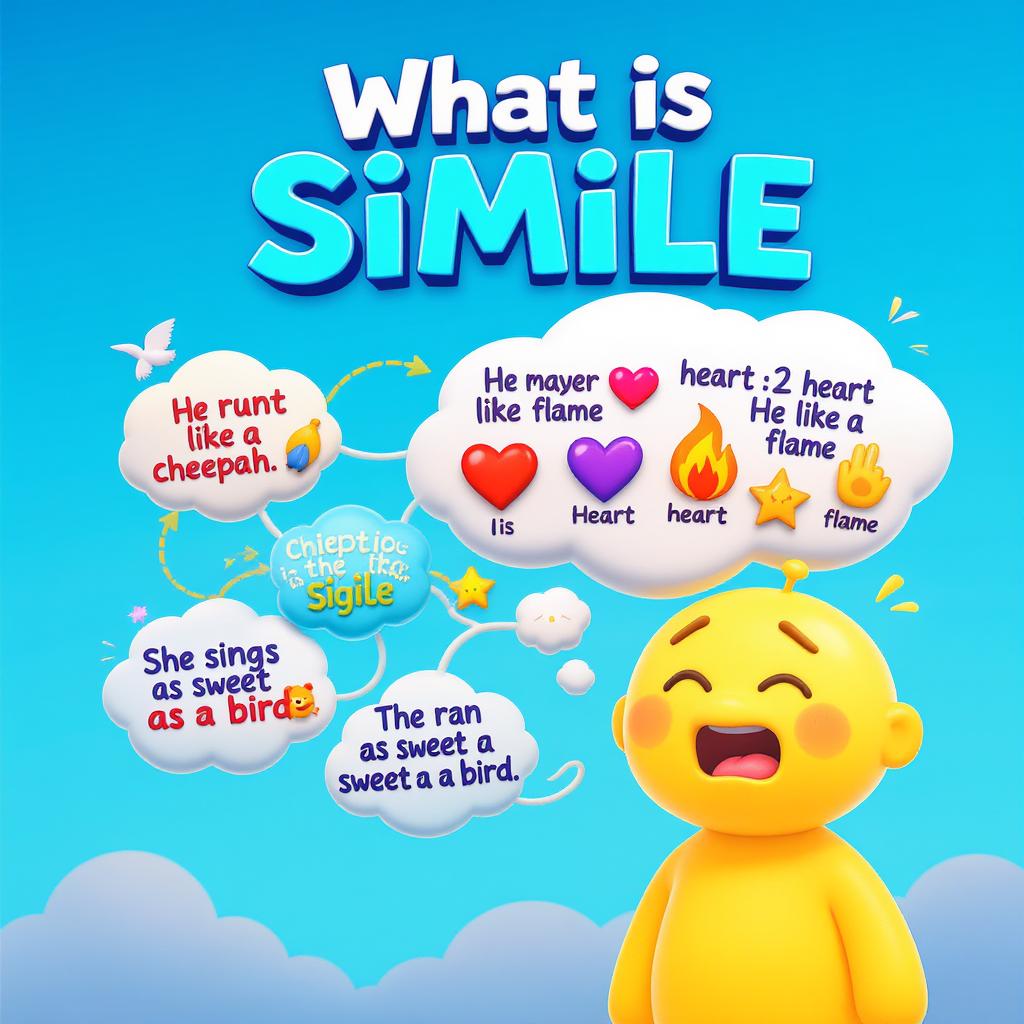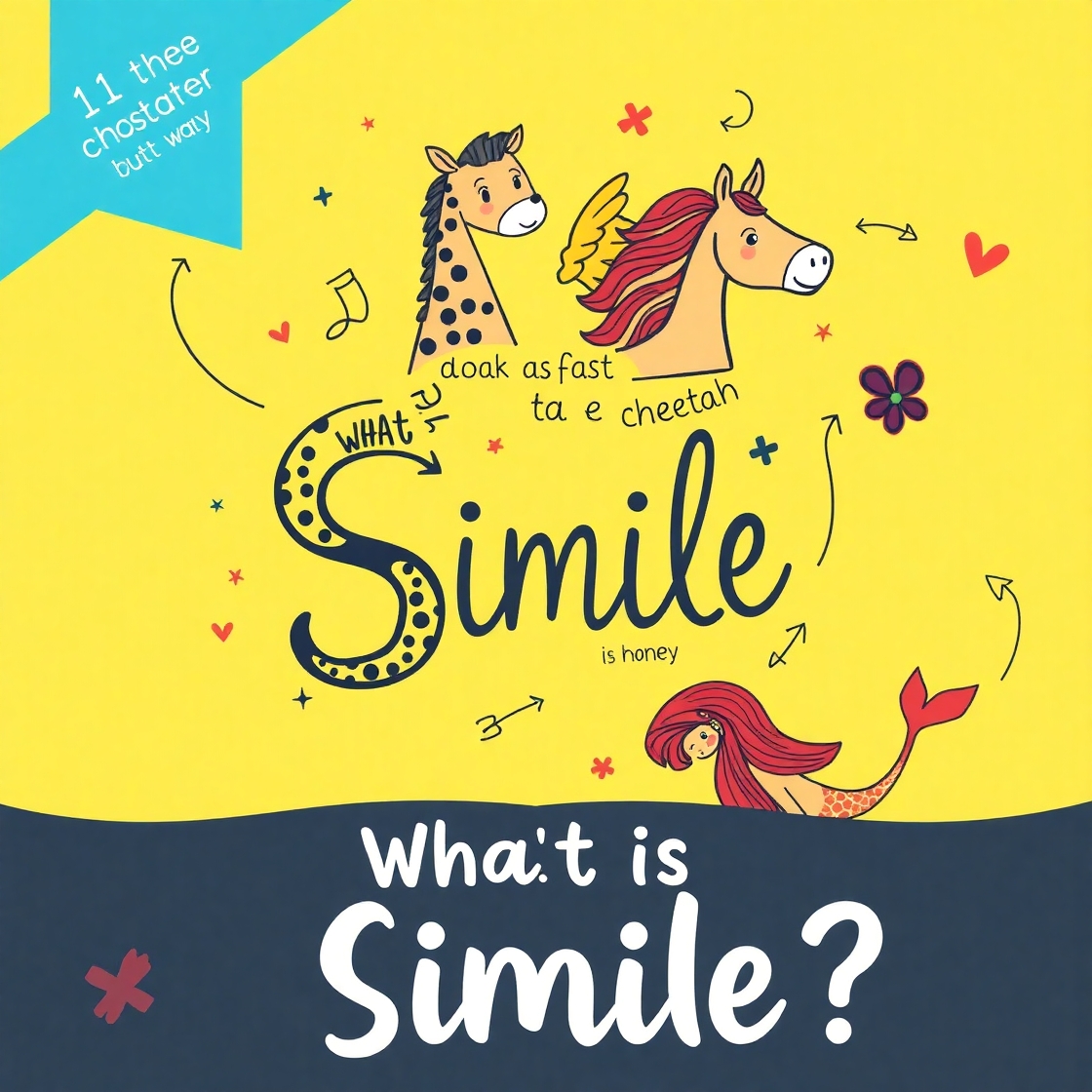In every written and spoken verbal exchange, figures of speech function as vital systems that improve the manner we precise thoughts. Rather than bringing up a few things certainly, those devices allow us to feature intensity, creativeness, and emotional effect to our phrases. By the use of creative comparisons, exaggerations, and sound patterns, figures of speech assist readers and listeners visualize the mind extra vividly. They convey language to existence, making it extra attractive and superb.
Some of the most common sorts encompass similes, which examine topics the usage of “like” or “as”; metaphors, which advise comparisons with out the ones connectors; personification, which gives human dispositions to non-human topics; alliteration, the repetition of initial consonant sounds; and hyperbole, or planned exaggeration for emphasis. Together, the ones gear supply writers and audio tools in an effective manner to talk extra successfully and creatively.
What Is a Simile? Understanding the Basics

A simile is an effective literary tool used to draw an easy and extremely good assessment amongst in assessment to subjects. It does this through using connecting terms collectively with “like” or “as.” This determination of speech lets writers and audio gadgets make descriptions extra attractive and relatable with the useful resource of attractiveness to the reader’s creativity.
Clear Definition:
In smooth phrases, a simile compares numerous topics to attention on a shared amazing or trait. This approach lets in summary thoughts or normal recollections to be expressed in a more placing and noteworthy manner.
Example Definition:
A simile is a descriptive tool that hyperlinks splendid elements using “like” or “as” to emphasize a component of similarity among them.
Basic Simile Examples:
- “She ran as rapidly as a cheetah.”
- “His hands had been cold like ice.”
- “The room is now as quiet as a cemetery.”
These examples don’t in reality tell us how some issue is—they show us, assisting readers visualize, experience, or draw near the due to this on an emotional level.
How Similes Are Structured
Similes typically examine a clean and regular grammatical sample, making them smooth to understand and use. The shape typically looks as if this:
[Subject] [verb] as/like [comparison]
Let’s ruin down some commonplace examples the usage of this format:
- “The little one is as mild as a feather.”
- (Subject = the little one, Verb = is, Comparison = as mild as a feather)
- “He fights like a lion.”
- (Verb: battles, comparison: like a lion, subject: he.)
- “Her voice has been modified to be as candy as honey.”
- (Subject = her voice, Verb = turn out to be, Comparison = as candy as honey)
What Makes a Good Simile?
A sturdy smile is very correct and creative. The selected assessment ought to be relatable to your goal marketplace and evoke an easy intellectual photo. The motive isn’t clearly to decorate language—it’s to make easy or intensify an enjoyment, motion, or feature in a revolutionary manner.
Read More: 30 Funny Similes
Why Do Writers and Speakers Use Similes?
Similes are an effective device in both writing and normal speech. They enhance language through the usage of which consist of readability, emotion, and creativity, making verbal exchange more attractive and lots lots lots much less hard to apprehend. Here’s a breakdown of why similes are so considerably used inside the direction of considered one in every of a type sorts of expression:
1. To Create Vivid Mental Images (Visualization)
One of the simplest blessings of the usage of a simile is its capability to colour a photograph in the listener’s or reader’s thoughts. By drawing comparisons among not like subjects, similes assist to describe scenes, gadgets, or human beings in a manner that feels acquainted and visually specific.
Example:
- “Her eyes sparkled like stars.”
- This immediately inspires brightness and beauty, assisting the reason the market truly visualizes what’s being defined.
2. To Evoke Emotion and Mood
Similes can add emotional texture to a sentence. Whether it’s delight, sadness, anger, or love, similes permit the speaker or writer to talk emotions more vividly through a way of connecting them to bodily sensations or familiar evaluations.
Example:
- “His terms reduce like a knife.”
- This creates a pointy emotional effect, emphasizing how deeply the phrases affected a person.
3. To Make Complex Ideas More Understandable (Clarification)
Abstract or technical necessities may be tough to recognize. Similes make them relatable with the useful resource of way of comparing them to ordinary critiques that the purpose market already is acquainted with.
Example:
- “The financial device is the form of a rollercoaster.”
- This clean assessment conveys the unpredictable highs and lows of the monetary tool in a manner without a doubt all and sundry can hold near.
4. To Enhance Creativity and Style
Similes inject individuality and artistry into writing. Whether you’re composing a poem, telling a story, or giving a speech, a nicely-determined on simile can rework ordinary language into some issue revolutionary and wonderful.
Example:
- “The clouds floated in some unspecified time inside the destiny of the sky like cotton candy at a sincere.”
- This turns a commonplace sight into some whimsical and amazing factor, taking the reader’s hobby through creativity.
Common Similes You Hear Every Day
Similes are not absolutely literary tools—they’re an important part of how humans without a doubt communicate and write. Whether in informal chats, songs, commercials, or films, similes assist our particular mind more vividly and memorably. Below are some familiar examples you’ve possibly heard or used without even statistics it:
- As busy as a bee
- (Describes a person who’s very active or constantly strolling)
- As cool as a cucumber
- (Used to offer a reason for a person who stays calm beneath stress)
- As sharp as a tack
- (Refers to someone who’s very realistic or quick-witted)
- As blind as a bat
- (Describes someone with terrible imaginative and prescient or who ignored some issue apparent)
- Like searching paint dry
- (Used humorously to provide an purpose of a few trouble substantially boring)
- As smooth as pie
- (Describes a few problem that’s pretty smooth to do)
- Sleep like an infant
- (Refers to sleeping deeply and peacefully)
- Fight like cats and puppies
- (Used to offer an purpose of individuals who argue or quarrel frequently and fiercely)
These expressions make language revel in greater relatable and expressiveness. They are part of complex or precise reviews to familiar comparisons, making our verbal exchange greater colourful and powerful.
The Power of Similes in Literature and Poetry

Similes have long been cherished via writers and poets for their functionality to hold language to life. By evaluating feelings, gadgets, or studies to splendid imagery, similes deepen the emotional resonance of a text and paint powerful highbrow images for the reader.
Renowned literary figures have used similes to masterful impact. Let’s discover a few iconic examples:
Shakespeare’s Use of Similes
William Shakespeare frequently used similes to articulate love, splendor, and the human situation. His works are complete of rich comparisons that raise smooth thoughts into poetic masterpieces.
- “My love is kind of a purple, pink rose.”
- — This simile captures the depth and freshness of affection, evaluating it to the vibrancy and splendor of a blooming rose.
Robert Burns’ Romantic Imagery
Scottish poet Robert Burns appreciably applied similes with emotional readability. His well-known poem expresses affection in musical and herbal phrases:
- “Oh, my Life is a melody of sorts, played in a lovely tune.”
- — Here, love is in comparison to music, evoking concord and emotional depth in just a few brief lines.
Why Similes Work in Creative Writing
In literature and poetry, similes serve numerous vital roles:
They increase imagery.
Readers can better visualize scenes and characters at the same time as comparisons make descriptions greater relatable.
They make emotions tangible.
Abstract feelings like love, fear, or pride emerge as less difficult to comprehend even as tied to concrete examples.
They upload beauty and rhythm.
A nicely-crafted simile gives musicality to language and keeps the reader engaged.
Similes enable authors to transform commonplace ideas into unforgettable instances of profound emotional expression and creative expression, whether in a romantic sonnet or a dramatic scenario.
Fun and Creative Similes
Similes don’t continuously have to be immoderate or poetic—they may be delightfully modern-day, quirky, and fun! These varieties of comparisons are particularly powerful in funny writing, storytelling for kids, or everywhere a hint of man or woman and laughter is welcome.
Here are a few playful examples designed to spark imagination and entertain readers:
- As worried as a mouse at a cat conference
- (Perfect for expressing intense anxiety or jitters in a moderate-hearted manner.)
- As clumsy as a giraffe on roller skates
- (A whimsical manner to offer the purpose of someone who’s feeling out of stability or bodily awkward.)
- As exhausted as a sloth after strolling a triathlon
- (A comical exaggeration that highlights in truth how tired someone feels.)
- As satisfied as a home canine in a ball pit
- (Captures uncontainable happiness and satisfaction.)
- As baffled as a goat seeking out to play chess
- (Illustrates confusion in an exaggerated and humorous fashion.)
These colorful comparisons aren’t sincerely specific—similarly they paint memorable highbrow pix that help readers be part of emotionally. That’s what similes this form of effective device, not splendid for pro writers however furthermore for university university college college students and language newcomers exploring the more colourful hassle of communique.
MCQs What is a Simile
1. What is the number one cause of the usage of a simile in language?
A) To provide actual facts
B) To examine same matters
C) To create vibrant and progressive comparisons
D) To repeat the same sound
✅ Correct Answer: C) To create extremely good and imaginative comparisons
2. Which connecting words are commonly utilized in similes?
A) But and so
B) If and while
C) Like and as
D) With and thru using
✅ Correct Answer: C) Like and as
3. Identify the simile from the subsequent sentences:
A) She is the queen of the dance floor.
B) His anger came to be thunder in the sky.
C) Her palms had been as cold as ice.
D) He has turned out to be a lion in conflict.
✅ Correct Answer: C) Her arms were as cold as ice.
4. Why do writers use similes in revolutionary writing and poetry?
A) To extend their content material
B) To confuse the audience
C) To add rhythm and colorful imagery
D) To lessen word depend
✅ Correct Answer: C) To add rhythm and outstanding imagery
5. Which of the subsequent is an instance of a simile expressing emotion?
A) The sun smiled on us.
B) His phrases reduce like a knife.
C) The tree danced inside the wind.
D) Her laughter crammed the room.
✅ Correct Answer: B) His terms reduce like a knife.
6. What does the simile “as busy as a bee” suggest?
A) Someone who enjoys honey
B) Someone who is very hardworking or active
C) Someone who flies spherical all day
D) Someone who stings others
✅ Correct Answer: B) Someone who’s very hardworking or lively
7. In the sentence “The toddler is as slight as a feather,” what’s the cause of the simile?
A) To describe how moderate the little one feels
B) To show the toddler is napping
C) To display the toddler is strong
D) To say the toddler is type of a bird
✅ Correct Answer: A) To describe how slight the child feels
8. What makes a simile effective and great?
A) It compares unrelated topics with out reason
B) It makes use of complicated and tough vocabulary
C) It creates an easy, relatable intellectual photo
D) It avoids emotional language
✅ Correct Answer: C) It creates a smooth, relatable highbrow photo
9. Which poet uses the simile “My love is a type of a purple, purple rose”?
A) William Shakespeare
B) Emily Dickinson
C) Robert Frost
D) Robert Burns
✅ Correct Answer: D) Robert Burns
10. Which of the following is an amusing, funny simile from the object?
A) As glad as a lark
B) After a marathon, as exhausted as a sloth
C) As rich as a king
D) As fast as the wind
✅ Correct Answer: B) After a marathon, as exhausted as a sloth
Final Words
Similes aren’t definitely an elaborate device for poets and novelists—they’re an effective manner for all people to speak with greater clarity, emotion, and creativity. Whether you are attempting to describe the intensity of a person’s love, the sharpness of a remark, or simply how tired you feel, a nicely-selected simile brings your phrases to existence. It turns regular language into a few aspects that are vivid and memorable.
By evaluating subjects the use of “like” or “as,” similes help us provide a cause of the precis, add humor, express emotion, and construct imagery that connects with people on a deeper degree. From traditional literature to normal conversation, they may be anywhere—evidence of their lasting energy in human expression.
So subsequent time you write or talk, strive slipping in a simile. Whether it’s “as clean as morning dew” or “like a rocket commencing,” you’ll no longer handiest say extra—you’ll say it higher.
Read More About Similes At Digital Reserved

